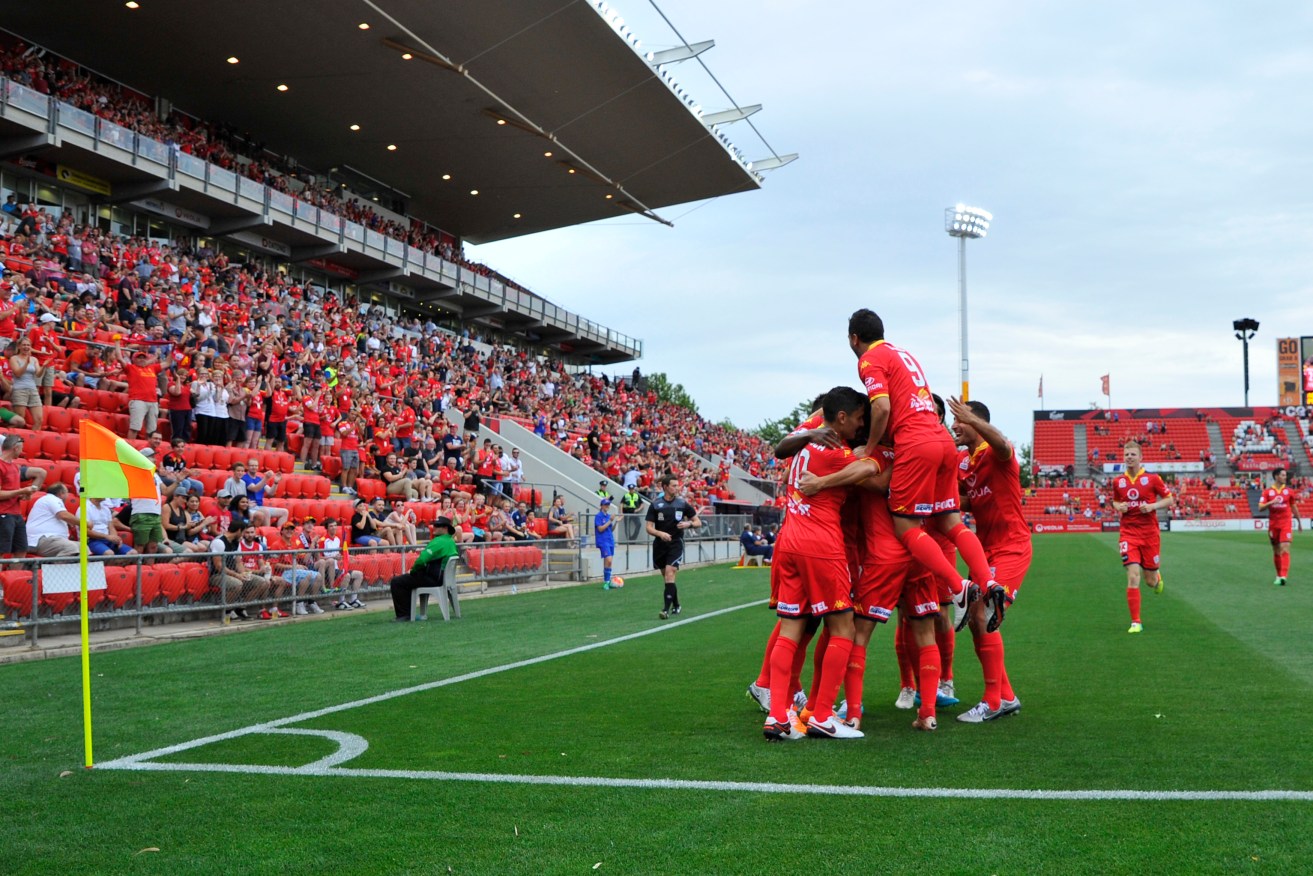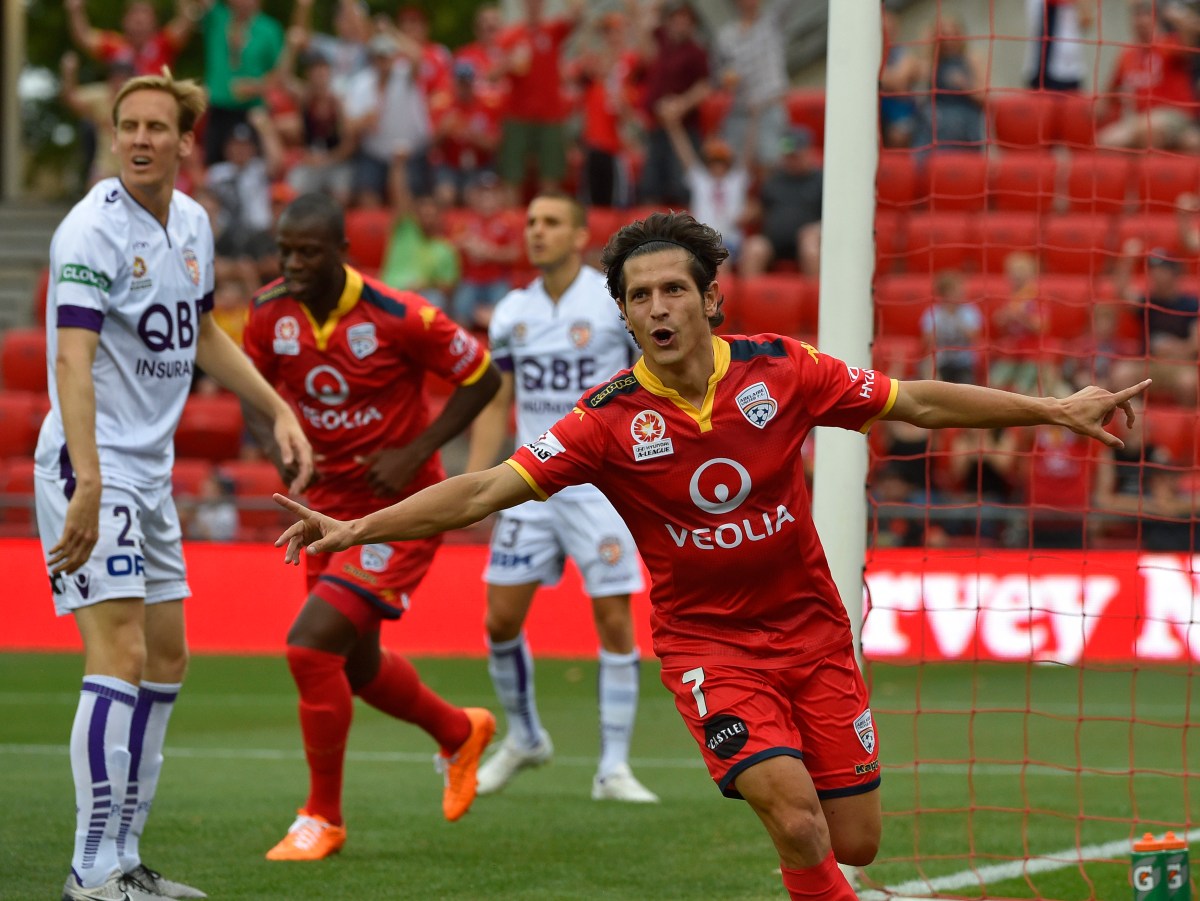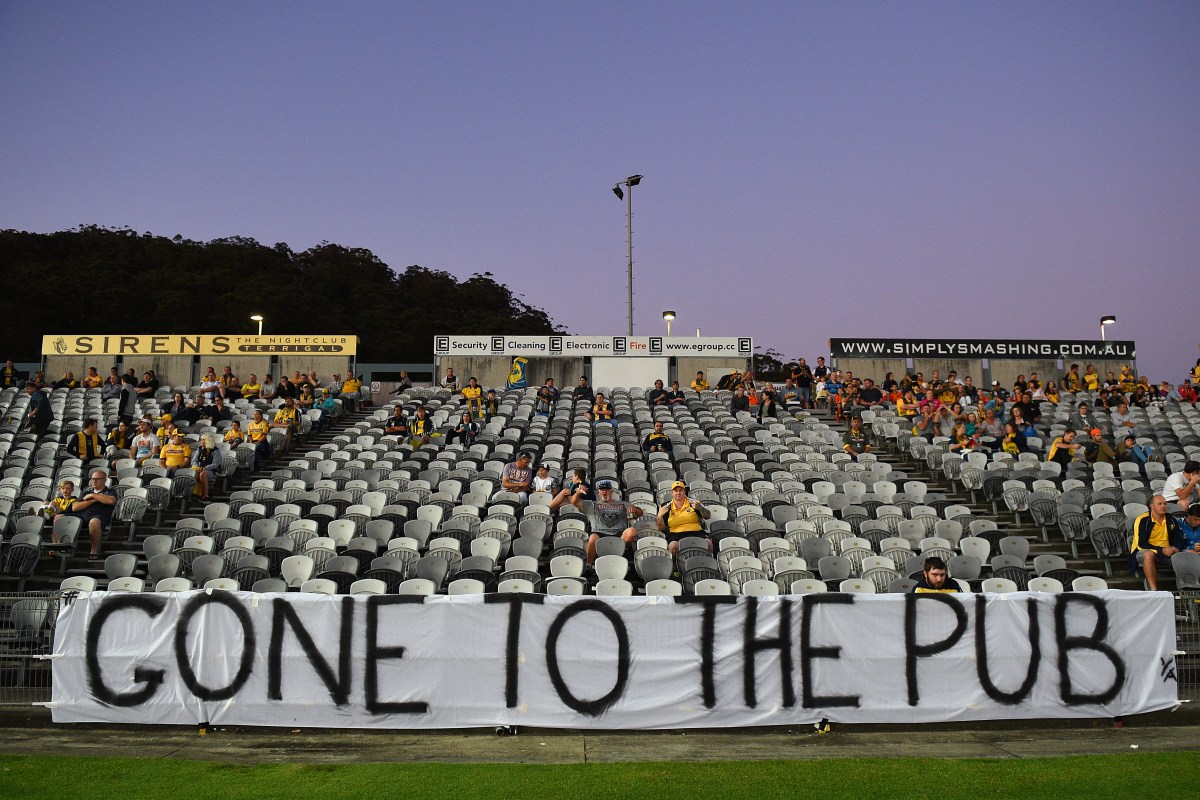We’re no different to the rest of you
Despite attempts by the tabloid media to stereotype soccer fans, they’re remarkably similar to other Australian sports supporters, argues Paul Marcuccitti.

Adelaide United players celebrate an early goal against Perth Glory at Coopers Stadium on Sunday. AAP Image/David Mariuz
On 19 April 1989, the headline of The Sun newspaper in the United Kingdom was “The Truth”.
The story claimed that, during the Hillsborough disaster (which had occurred four days earlier), Liverpool fans pick pocketed crushed victims, urinated on police, and that a police constable was assaulted while he was trying to save a patient’s life.
The Sun would eventually write that it made “a terrible mistake” and would describe that story as “inaccurate and offensive”. In 2012.
But it will never be forgiven by Liverpudlians and, not surprisingly, its circulation on Merseyside is considerably lower than it was in the 80s.
Nevertheless, when The Sun published its lies, its editor probably felt he was on safe ground. Trouble at matches was more common in those days and Liverpool fans were easy targets after their involvement in the Heysel disaster just four years earlier.
It’s hard to believe now but in the late 1980s, some questioned whether the sport would survive. In the country of its birth.
That speculation – quite laughable with hindsight – was fuelled by frequent stories about crowd trouble. And no one sensationalised them better than The Sun, a News Corp paper.
Problems in or around a stadium? Default to hooliganism.
(This, no doubt, would have been noticed by an Australian journalist called Bruce Wilson who worked in Britain in the late 1980s. You may have heard of one of his daughters, Rebecca.)
Although the Hillsborough tragedy was by far the worst of its kind in England, the tabloids’ formula for covering such stories was already well established: blame the fans, find justification for doing so (however flimsy), print.
Three years after one of his newspapers was demonising innocent fans, Rupert Murdoch paid £191 million to broadcast the EPL
Eventually the Hillsborough Independent Panel (set up by the British government) found that no Liverpool fans were responsible for the disaster and blamed the police. But this conclusion – the real truth – was reached only three years ago and, among other things, prompted The Sun’s apology.
In its first issue after the tragedy, one of England’s best fanzines, When Saturday Comes, wrote a lengthy but prescient editorial (behind a memorable front cover). You can read all of it if you like but I’ve picked out a few relevant paragraphs. Bear in mind that this was written by fans in England more than a quarter of a century ago:
“The police see us as a mass entity, fuelled by drink and a single-minded resolve to wreak havoc by destroying property and attacking one another with murderous intent. Containment and damage limitation is at the core of the police strategy. Fans are treated with the utmost disrespect.
“The implication is that “normal” people need to be protected from the football fan. But we are normal people. ‘The Football Fan’ is not an easily defined social stereotype, whatever the tabloid cartoonists may choose to believe. All manner of people go to football matches.
“Then there are the administrators. Their attitude is one of utter incomprehension and cowardice. They don’t stick up for football supporters because they basically neither understand nor like them.
“We are informed, with wearying regularity, that football needs to ‘put its house in order’.
“There is very little common sense applied to football. In no other area of life is the victim treated with as much disrespect as the perpetrator, nor the majority held to be guilty of the crimes perpetrated by a minority.”
Sound familiar?
Of course I’m not comparing the last two weeks in Australian soccer to Hillsborough (indeed, my eyes roll when I see the word “crisis” used when discussing Football Federation Australia and the A-League).
Nevertheless the parallels with the sections I’ve selected from that editorial are quite remarkable.
The way police see fans? The sport needing to put its house in order? Step forward NSW Police Commissioner Andrew Scipione: “The sport must look deep within its culture to admit there is a problem.” (This might have already happened with the banning of 198 fans.) “The last thing we want to get to in Australia is putting rival fans in cages like the UK model.” (Those cages were removed in 1989. Because they contributed to the Hillsborough deaths.)
The administrators not sticking up for supporters? I covered that at length last week. Since then there have been another two press conferences and neither convinced fans that their governing body was on their side.
The majority deemed guilty because of crimes perpetrated by a minority? A staple of tabloid media’s coverage.
It’s been somewhat touching seeing other columnists giving Rebecca Wilson their backing and trying to write similar pieces. That they’re all News Corp employees is surely just a coincidence.
Like the British rags of the 1980s, they follow a fairly simple formula. Because we’re in Australia it’s a little different. For example it includes the I-went-to-a-game-once part. Unfortunately Susie O’Brien of the Herald Sun forgot that line so she ended up sounding like an ill-informed talkback caller when she tried to defend her column in a radio interview.
That leaves these lines from that 1989 editorial: “The implication is that ‘normal’ people need to be protected from the football (soccer) fan. But we are normal people.”

Pablo Sánchez Alberto reacts after scoring United’s only winning goal this season – ironically, many supporters weren’t there to savour the win. Photo: AAP
When journos are looking for Adelaide United fans to feature, Steve Cervaro is a natural fit. His big red wig and his frequent interstate travel make him one of the club’s most recognisable faces. He’s typical of those soccer people, right?
Not so fast.
I’ve never spoken to Cervaro but he regularly appears as a suggested friend on my Facebook page. It’s not surprising as we have several mutual friends. But his name on his Facebook page (and this has appeared in media before) is “Steve Collingwood Cervaro”.
What’s that? He loves Aussie Rules? So much that he brings his favourite AFL team into his name?
A colleague who rarely misses an Adelaide United match, and regularly travels to watch the Reds play away, is also a massive AFL fan. His office is decorated with photos of Crows players, particularly the ones that won premierships some time last century.
At the 2010 FIFA World Cup in South Africa, I was sharing rooms with chaps from Sydney who regularly went to NRL games to follow the Roosters.
And I’ve been going to watch Aussie Rules since I was a kid. My AFL team is in Victoria … but not in Melbourne … and I never miss its matches in Adelaide. I usually go interstate to see one or two games each year as well.
In fact most of those people you see at A-League matches, whether or not they’re in the active supporter section, enjoy other sports. So yeah, we’re not some alien race.
So much for the idea – sometimes advanced by paranoid anti-soccer scribes – that we think we’re going to take over one day. If that was our attitude we’d never put our money into rival codes.
We create a different atmosphere at soccer matches thanks to the examples we have from passionate fans around the globe. But it’s not dangerous. The myth that you’re less safe than you would be at any other sporting event is just that.

The Mariners’ core supporter base vacated their usual home, making no secret of their alternative destination during last week’s game. Photo: Dan Himbrechts / AAP
But if you don’t like us, I have some bad news. Despite these last two awkward weeks, the game will survive.
It may even thrive. Three years after one of his newspapers was demonising innocent fans in the most appalling way, Rupert Murdoch’s BSkyB paid £191 million to broadcast the English Premier League. The next TV rights deal is worth £5.1 billion.
England may be where the game began but the Premier League also brought in a new class of fan – those who follow the sport are now seen as “normal people”.
While it’s been less dramatic, that shift in perception has been taking place here over the last 10 years as well. It has been a period of remarkable growth for the game and, despite occasional road bumps, it will continue.
And if that wasn’t the case, no one would ever bother to write about us.
Paul Marcuccitti is InDaily’s soccer columnist. He is a co-presenter of 5RTI’s Soccer on 531 program which can be heard from 11am on Saturdays.
Manton St Tales is normally published on Mondays during the A-League season.




